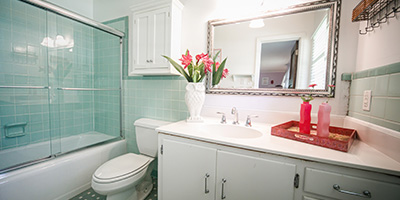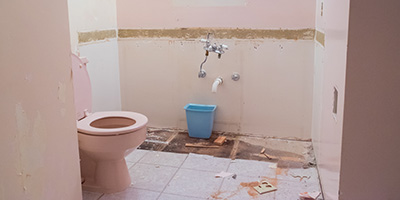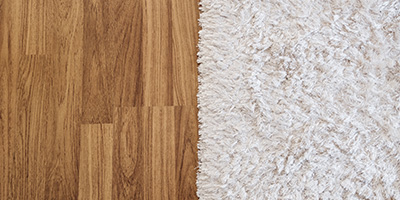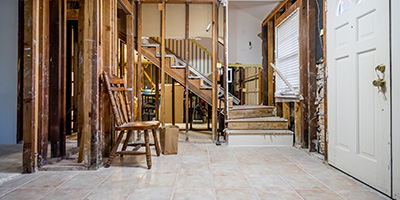A Complete Guide to Tax-Deductible Home Improvements
Keep a record of these house upgrades and investments to make the most of tax season.

How Tax Deductions for Home Improvements & Maintenance Work
If you recently remodeled your home, you may be wondering if the expenses can be deducted from your taxes. The first thing you need to ask yourself is: what’s considered a tax-deductible home improvement?
According to the IRS, a capital improvement is any upgrade that substantially adds value to your house, prolongs the life of your home or adapts it to new uses. For example, adding a room or second story to your house would bring significant value to your home. Or new plumbing and wiring can help prolong the life of your home, while demolishing your kitchen and modernizing it might help you adapt it to new uses.
Home Improvements vs. Home Repairs
There’s an important distinction between capital improvements that qualify for tax deductions and regular home repairs. Qualifying improvements and maintenance projects must improve the value — also known as the tax basis — of your home. Home repairs, however, merely keep the home in functional, operating condition. Below are a few examples of home improvements and home repairs:
Deductible Home Improvements | Non-Deductible Home Repairs |
|---|---|
Replacing an old roof | Patching a few leaky shingles |
Installing energy-efficient windows | Replacing a broken window pane |
Upgrading from laminate floors to hardwood | Fixing broken floorboards |
FAQs on Tax-Deductible Home Improvements
Are home improvements tax deductible?
It depends, but generally, any expenses that add something new to your home or upgrade an existing facet of the house can be deducted from your taxes at the time of your home’s sale.
Are home repairs tax deductible?
Generally, no, home repairs do not count towards tax deductions (unless you're a landlord working on a rental property). The IRS says repairs are fixes to keep your house in good condition but that do not substantially add value to your home. Examples include painting your house or fixing broken gutters.
However, there is an exception to the rule. Repairs made after a disaster, like a fire or a flood, that are necessary in order to restore your home to its condition before the damage will always count as tax-deductible home improvements.
When and how can I get tax deductions for home improvements?
In most cases, improvements and maintenance projects that qualify for deduction can reduce your taxes if and when you sell your home for a profit. However, some upgrades, including medical improvements, can be deducted within the year they were paid for.
You must keep a record of your improvements to get your deductions. The IRS provides a helpful home improvement record chart that allows you to note all improvements and their costs. Fill it out as you make home updates, and keep it in a folder with receipts, work orders and all other paperwork from your projects.

Keep in Mind
You cannot deduct improvements that have been removed or redone. For example, if you installed a chain link fence 10 years ago, but replaced it with a wood fence five years ago, the money spent on the chain link fence would not be a part of your home’s current value, and therefore could not be deducted when you sell.
Top 5 Tax-Deductible Home Improvements
Did you landscape your front yard or renovate your rental property within the last year? We talked to Stephen Fishman, attorney and legal writer for Nolo, Ginita Wall, a Certified Public Accountant and Financial Expert with TurboTax, and Laura Agadoni, the author of New Home Journal, to get some tips on home projects that can earn a tax write-off.
Let’s jump into some leading examples of home improvements that will provide you with some financial relief.

1. Energy-Efficient Improvements
If your home is running on natural energy, you’ve earned yourself a tax credit. One of the more obvious examples is adding solar panels to your roof to generate electricity.
Here are a few other sustainable upgrades that provide tax deductions:
- Wind turbines that generate electricity for residential use.
- Geothermal heat pumps that meet Energy Star guidelines.
- Solar-powered water heaters that heat at least half of the home’s water.
Depending on when you install these energy-efficient improvements, you’ll receive a different percentage of the cost. Here’s how Wall says the tax credit breaks down:
- 2019: The tax credit is 30% of the cost of the system.
- 2020: Owners of new residential solar can deduct 26% of the cost of the system from their taxes.
- 2021: Owners of new residential solar can deduct 22% of the cost of the system from their taxes.
In some areas, installing double- or triple-paned energy-efficient windows to trap cool air or heat inside may also qualify for a tax credit.

2. Medical Care Updates
Medically-necessary improvements with the primary purpose of providing care for whoever needs them are other eligible expenses to take away from your taxes. For example, aging-in-place modifications can be deducted in full with a doctor’s note. This would include the cost of medical equipment installation.
Examples of medical care home improvements include:
- Adding handrails in the shower.
- Installing a new ramp for wheelchair access.
- Widening doors and hallways to make room for wheelchairs.
- Adding a chairlift or elevator to get from one floor to the next.
- Installing a pool with a doctor's recommendation to help improve an ailment.
- Adding roll-under sinks in the kitchen and bathroom to accommodate wheelchairs.
Deduction amounts for these improvements must be reasonable and can’t include expenses made for aesthetic upgrades made in the process. According to Fishman, you can deduct 7.5% of your adjusted gross income for medical expenses. The money you spend to operate and maintain these additions can also be deducted. For example, you can deduct the cost of electricity to operate an elevator, but only if the elevator is used for medical purposes.

3. Home Office Updates
Do you work from home? If you’re a homeowner with basic working space or a small office at your residence, sorry, but you can’t deduct any investments made in your home office. However, if you use part of your house exclusively and regularly to operate a business, your home office renovations are tax-deductible. You'll simply need to provide documentation that you have a legitimate business to qualify.

“Whether you use part of your house, a single room, or part of a room, as long as you use it regularly for your business, you can deduct 100% of the improvements. This includes anything from painting or adding new lighting to installing new windows or flooring. Part of your rent or mortgage may even qualify as a tax-deductible expense.”
Some repairs and improvements made to other areas of your house may even be partially deductible, simply because you operate a business from your property and need to uphold its function to maintain success. If your office takes up 10% of your home, you can deduct 10% of the costs spent on your home. Home office-related expenses can be deducted within the year they are completed.

4. Rental Property Renovations
If you’re a landlord, additions or improvements made to a rental property may be tax-deductible. More good news: they don’t even need to be upgrades that add substantial value to the property, like most tax-deductible renovations.
Home repairs are not usually tax-deductible, but the costs of repairs to a rental property are fully-deductible within the year they are completed, as long as they are necessary in order to maintain a livable space for tenants and cost a reasonable amount.
Do you rent your home out as a temporary vacation rental? Whether you rent out your entire home or a room, expenses can be deducted proportionate to the number of days per year and how much of your home you rent out.

“It’s important to understand the difference between repairs and improvements for tax purposes. For example, let’s say your rental property’s roof is leaking. If you pay to get the roof repaired, you can deduct the entire cost. But if you replace the roof, you deduct the cost over multiple years.”
Tax-Deductible Repairs and Improvements for Landlords
Deductible Repairs | Deductible Improvements |
|---|---|
Repairing an air conditioner | Adding central air |
Replacing a broken kitchen cabinet | Renovating the entire kitchen |
Refinishing wood floors | Replacing wood floors |
Fixing appliances | Replacing appliances |
Replacing cracked tiles in the bathroom | Retiling the whole bathroom floor |

Pro Tip
Adding or replacing existing items are both considered improvements, which you would deduct over time. Improvements, such as renovating a bathroom or kitchen, add value to your property for many years to come, so you can’t deduct the entire cost in one year.

5. Improvements for Resale Value
If you made permanent improvements to your home that increased your resale value, these count as tax-deductible house improvements that can be added to your tax-cost basis and help you avoid taxes when you sell your house. However, these expenses are not deductible within the year they are spent. This includes big projects like adding a swimming pool and smaller upgrades like installing a home security system.
Some other examples to increase resale value include:
- Including an intercom system.
- Adding a new bedroom or garage.
- Landscaping your front yard to boost curb appeal and increase market value.
- Installing a new heating and cooling system, extra water tank or new septic tank.
- If accepted in your area, payments made each year on a home improvement loan can also be fully deducted from your taxes.
3 Popular Tax-Deductible House Improvements
There are a lot of different things you can do to upgrade your home. Here are some examples of projects you may have completed that can earn you a tax write-off.
Add a Wet Room in the Bathroom
A wet room provides a seamless transition from the bathroom floor to the shower floor. Essentially, they’re a continuation of one another separated by a door. Wet rooms are a popular addition to homes that need handicap modifications because having the shower and bathroom floor on the same level eliminates obstacles for wheelchairs and prevents slips and falls.
As an added bonus, wet rooms are a popular home design trend. They provide a modern look and are a sensible addition for older people preparing their homes for aging in place.
Complete a Home Expansion
Adding on to your home is a definite tax deduction at the time of sale because it increases the property’s resale value. Whether you finish your attic to add an extra room, add a walk-in closet or build an entire second story, you’re likely to see a return on investment.
Finish Your Basement
Did you add insulation, turn your basement into a home office or convert it into an apartment you can rent out? Finishing your basement is not a cheap affair. It can cost about $25-$50 per square foot, which can add up quickly. Look into getting the money you spent deducted from your taxes.
Evaluate Your Home Improvement Tax-Cost Basis
Figuring out your tax-cost basis will help you determine your profit when you sell your home. This is a great way to get tax benefits on any improvements you made that did not qualify for an immediate deduction and can reduce the amount of taxes you have to pay when you sell your home at a profit. The tax-cost basis is the amount of money you spent to buy or build your house, including closing costs, and the expenses to improve the home.
Tax-cost basis = what you paid for your house + money spent on home improvements
Subtract the tax-cost basis from your sale price to determine your profit.
Let’s say you bought your house for $400,000 and spent $50,000 on improvements. Your tax-cost basis, or the total amount of money you spent on the home, would equal $450,000. If you sold your house 25 years later for $900,000, you would gain $450,000.
- Single filers: First $250,000 of profit on the sale of a principal residence is tax-free.
- Joint filers: First $500,000 of profit on the sale of a principal residence is tax-free.

Pro Tip
Organize your home improvement receipts to prove you deserve a tax deduction. Keep them for as long as you own the property and up to three years after. Keep your home sale closing documents for the same amount of time.
Tackling Tax-Deductible Home Improvements on Your Own
If you’ve been inspired to plan some house upgrades, try taking them on yourself.
- Turning your garage into an office? Use our garage insulation guide.
- Ready to tackle a flooring project? Check out the most recent flooring trends.
- Want to increase resale value? Create a backyard oasis using our DIY backyard projects.
Rely on these resources and make sure to keep records of your work so you can deduct the expenses during the next tax season.
Need a container during a DIY home improvement project? Check out our different roll off dumpster sizes to find the right bin for you.
Expert Contributors

Stephen Fishman
Stephen is an award-winning legal writer, specializing in reader-friendly guides on small business and tax law. He has authored 18 books under the imprint of Nolo.com, known as one of the first legal sites. He lives in Oakland, CA area with his wife.

Ginita Wall
Gina is a financial expert and columnist for Turbotax. A nationally recognized expert on women and money, she has authored eight books and has been quoted in numerous publications such as The Wall Street Journal and USA Today. Living and working in San Diego, she has presented financial seminars for organizations such as Charles Schwab, Sharp Hospital and many more.

Laura Agadoni
Specializing in real estate and personal finance writing, Laura is a published author and founder of Landlordology. Based in Atlanta, she provides expert home investment tips, real estate advice and resources to successfully manage your properties and build wealth.
Other Sources
Selling Your Home (2022, January 18). Retrieved from IRS.gov
Federal Tax Credits: Geothermal Heat Pumps. Retrieved from Energystar.gov
How Much Does it Cost to Remodel a Basement? (2022, January 12). Retrieved from CostOwl.com
What Do You Think?
Deducting a home improvement in your tax return? We're listening. Head over to Twitter or Facebook,
and use #dumpstersblog to join the conversation.







